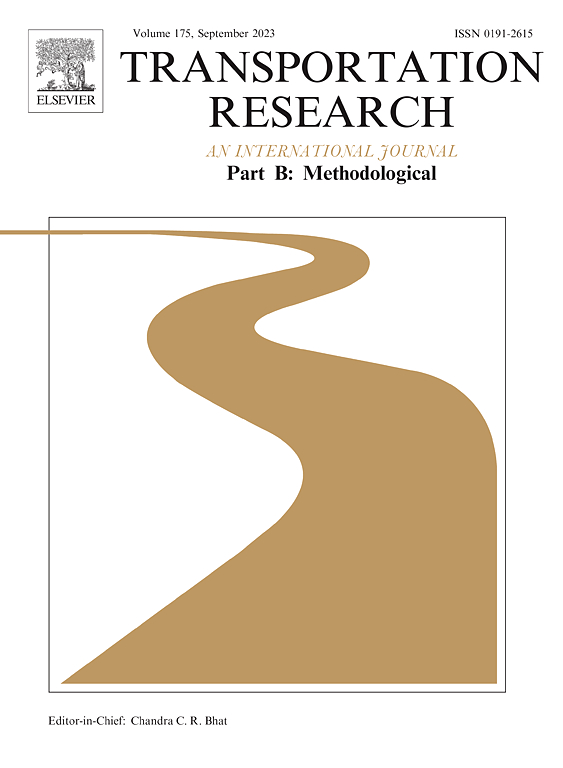自动驾驶道路数字化基础设施投融资
IF 5.8
1区 工程技术
Q1 ECONOMICS
引用次数: 0
摘要
联网自动驾驶汽车(cav)配备了传感器,使它们能够扫描和分析周围环境。这种能力使自动驾驶汽车能够就他们的行动做出明智和有效的决策;然而,这些传感器有限的空间范围和分辨率为实现完全自主提出了挑战。通过车对车(V2V)和车对基础设施(V2I)通信的协同传感为丰富自动驾驶汽车的环境理解提供了另一种方法。本研究探讨了在不同交通流条件下,车辆互联和路边传感器部署的最优投资策略。它还将自融资定理扩展到配备传感器的道路,并研究了最优收费是否可以同时覆盖建设成本和配备传感器组件的道路成本。自动驾驶汽车机动性的程式化模型考虑了作为基础设施一部分的路边固定传感器与自动驾驶汽车移动传感器之间的相互作用。结果表明,在预算受限和低交通流量的情况下,投资于基础设施改善是首选。然而,随着交通流量的增加,优先考虑自动驾驶汽车之间的连接和数据共享变得更加有利可图。值得注意的是,在高交通流量中,根据系统设置,可能会发生转向投资固定传感器的情况。该研究结果为提高CAV性能的预算分配提供了见解,促进了高效安全自动驾驶系统的发展。对自融资定理的分析也表明,最优用户通行费不包括建设数字基础设施的成本。然而,如果社会规划者考虑到配备传感器的道路的安全效益,则数字基础设施的建设可以由最优用户通行费覆盖。此外,如果现有道路的流量容量比大于某个阈值,则最优用户通行费的收入可以覆盖为现有道路安装传感器的成本。本文章由计算机程序翻译,如有差异,请以英文原文为准。
Investment and financing of roadway digital infrastructure for automated driving
Connected automated vehicles (CAVs) are equipped with sensors, enabling them to scan and analyze their surrounding environment. This capability empowers CAVs to make informed and efficient decisions regarding their motion; however, the limited spatial range and resolution of these sensors present challenges for achieving full autonomy. Cooperative sensing through vehicle-to-vehicle (V2V) and vehicle-to-infrastructure (V2I) communications offers an alternative approach to enrich CAVs’ environmental understanding. This study explores the optimal investment policy for vehicular connectivity and road-side sensor deployment under varying traffic flow conditions. It also extends the self-financing theorem to the sensor equipped roads and investigates whether an optimal toll can cover both the construction costs and the costs of equipping roads with sensing components. The stylized model of CAV mobility considers the interplay between stationary sensors installed road-side as a part of the infrastructure and mobile sensors of CAVs. Results indicate that under constrained budgets and low traffic flow, investing in infrastructure improvement is preferred. However, as traffic flow increases, prioritizing connectivity and data sharing among CAVs becomes more lucrative. Notably, in high traffic flow, a shift back to investing in stationary sensors may occur, depending on system settings. The findings provide insights into budget allocation to enhance CAV performance, advancing the development of efficient and safe automated driving systems. The analyses on the self-financing theorem also show that the optimal user tolls do not cover the cost of constructing digital infrastructure. However, if social planners consider the safety benefits of sensor equipped roads, the construction of digital infrastructure can be covered by the optimal user tolls. In addition, the revenue from optimal user tolls can cover the cost of equipping existing roads with sensors if their flow-capacity ratio is greater than a certain threshold.
求助全文
通过发布文献求助,成功后即可免费获取论文全文。
去求助
来源期刊
CiteScore
12.40
自引率
8.80%
发文量
143
审稿时长
14.1 weeks
期刊介绍:
Transportation Research: Part B publishes papers on all methodological aspects of the subject, particularly those that require mathematical analysis. The general theme of the journal is the development and solution of problems that are adequately motivated to deal with important aspects of the design and/or analysis of transportation systems. Areas covered include: traffic flow; design and analysis of transportation networks; control and scheduling; optimization; queuing theory; logistics; supply chains; development and application of statistical, econometric and mathematical models to address transportation problems; cost models; pricing and/or investment; traveler or shipper behavior; cost-benefit methodologies.

 求助内容:
求助内容: 应助结果提醒方式:
应助结果提醒方式:


